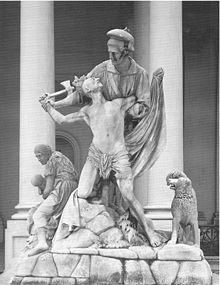Racism against Native Americans in the United States
The 19th century witnessed a surge in efforts to forcibly remove certain Native American nations, while those who remained faced systemic racism at the hands of the federal government.
Ideologies like Manifest destiny justified the violent expansion westward, leading to the passage of the Indian Removal Act of 1830 and armed clashes.
The dehumanization and demonization of Native Americans, epitomized in the United States Declaration of Independence, underscored a pervasive attitude that underpinned colonial and post-colonial policies.
Native Americans are overrepresented and receive harsher sentences in the criminal justice system, and experience severe disparities in health and healthcare.
However, some Native Americans either chose to or were allowed to remain on their land and as a result, they avoided removal but thereafter, the federal government treated them in a racist manner.
The Choctaws in Mississippi described their situation in 1849, "we have had our habitations torn down and burned, our fences destroyed, cattle turned into our fields and we ourselves have been scourged, manacled, fettered and otherwise personally abused, until by such treatment some of our best men have died.
"[4] According to Charles Hudson, Joseph B. Cobb, who moved to Mississippi from Georgia, described the Choctaws as having "no nobility or virtue at all, and in some respects he found blacks, especially native Africans, to be more interesting and admirable, the red man's superior in every way.
[6] A justification for the conquest and subjugation of indigenous people emanated from the stereotyped perception that Native Americans were "merciless Indian savages" (as described in the United States Declaration of Independence).
[7] Sam Wolfson in The Guardian writes, "The declaration’s passage has often been cited as an encapsulation of the dehumanizing attitude toward indigenous Americans that the US was founded on.
"[8] Simon Moya-Smith, culture editor at Indian Country Today, states, "Any holiday that would refer to my people in such a repugnant, racist manner is certainly not worth celebrating.
[23] Native American nations on the plains in the west continued armed conflicts with the U.S. throughout the 19th century, through what were called generally Indian Wars.
"[25] Xabier Irujo, professor of genocide studies at the University of Nevada, Reno, stated, "the toll on human lives in the wars against the native nations between 1848 and 1881 was horrific.
The Whites, by the law of conquest, by a justice of civilization, are masters of the American continent, and the best safety of the frontier settlements will be secured by the total annihilation of the few remaining Indians.
"[30] Following the December 29, 1890, massacre, Baum wrote, "The Pioneer has before declared that our only safety depends upon the total extermination [sic] of the Indians.
[36][37] Further dispossession of various kinds continues into the present, although these current dispossessions, especially in terms of land, rarely make major news headlines in the country (e.g., the Lenape people's recent fiscal troubles and subsequent land grab by the State of New Jersey), and sometimes even fail to make it to headlines in the localities in which they occur.
[38] The Worldwatch Institute notes that 317 reservations are threatened by environmental hazards, while Western Shoshone land has been subjected to more than 1,000 nuclear explosions.
[40] In early colonial writings, the most common portrayal of Native men came in the form of what Robert Berkhofer calls "savage images of the Indian as not only hostile but depraved.".
[50] While formal equality has been legally recognized, American Indians, Alaska Natives, Native Hawaiians, and Pacific Islanders remain among the most economically disadvantaged groups in the country, and according to national mental health studies, American Indians as a group tend to suffer from high levels of alcoholism, depression and suicide.
The initial lack of media coverage and accountability has resulted in Indigenous-led movements such as Native Lives Matter and Missing and Murdered Indigenous Women, Girls, and People.
Native Americans are incarcerated at a rate 38% higher than the national average and were overrepresented in the prison population in 19 states compared to any other race and ethnicity.





